Tiliqua rugosa
Tiliqua rugosa is a short-tailed, slow-moving species of blue-tongued skink found in Australia. Three of the four[2] recognised subspecies are found only in Western Australia, where they are known collectively by the common name bobtail.[3] The name shingleback is also used, especially for T. rugosa asper, the only subspecies native to eastern Australia.
| Tiliqua rugosa | |
|---|---|
 | |
| Eastern shingleback | |
| Scientific classification | |
| Kingdom: | Animalia |
| Phylum: | Chordata |
| Class: | Reptilia |
| Order: | Squamata |
| Family: | Scincidae |
| Genus: | Tiliqua |
| Species: | T. rugosa |
| Binomial name | |
| Tiliqua rugosa | |
| Subspecies | |
|
Four; see text | |
| Synonyms | |
|
Trachydosaurus rugosus | |
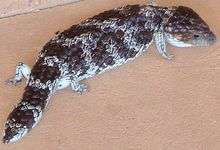
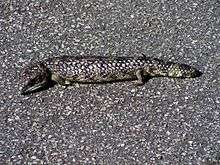
Apart from bobtail and shingleback, a variety of other common names are used in different states, including stump-tailed skink, bogeye or boggi,[4] pinecone lizard and sleepy lizard.[2] Aboriginal names include Yoorn in the Nyungar language.[5]
Tiliqua rugosa has a heavily armoured body and can be found in various colours, ranging from dark brown to cream. It has a short, wide, stumpy tail that resembles its head and may confuse predators. The tail also contains fat reserves, which are drawn upon during brumation in winter. This skink is an omnivore; it eats snails and plants and spends much of its time browsing through vegetation for food. It is often seen sunning on roadsides or other paved areas.
Etymology and taxonomy
The species was first described by John Edward Gray in 1825 as Trachydosaurus rugosus.[1][2] It is now classified as Tiliqua rugosa. Some herpetologists claim this species has more common names than any other lizard.[6]
Subspecies
Four subspecies of T. rugosa are currently recognised:[2]
- T. r. rugosa: bobtail or western shingleback – Western Australia
- T. r. asper:[7] eastern shingleback – eastern Australia
- T. r. konowi:[8] Rottnest Island bobtail or Rottnest Island shingleback – Rottnest Island, Western Australia
- T. r. palarra:[9] northern bobtail or Shark Bay shingleback – Shark Bay, Western Australia
Distribution and habitat
The species is widely distributed in arid to semiarid regions of southern and western Australia. The range extends from Shark Bay, Western Australia, across the southern-most regions of the country to the coast, then north into Queensland. Four subspecies are found in Western Australia, including one at Rottnest Island. It also occurs in the eastern states of Victoria and New South Wales, but does not reach coastal areas.[10]
The habitat of the species includes shrublands and desert grasslands to sandy dunes. These skinks are well known, due to a preference for sun basking in open areas, and are often seen along roadsides or other cleared areas in its range.[11] On average, individuals have a home range of four hectares, and can move up to 500 metres per day.[12]
Description
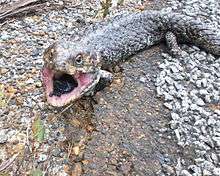
Tiliqua rugosa has a heavily armoured body and can be found in various colours, ranging from dark brown to cream.[6] Its snout–vent length varies from 260 to 310 mm (10 to 12 in),[13] but it is a very heavy-bodied lizard for its length.[6]
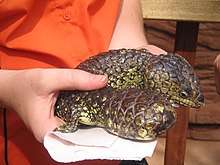
It has a triangular head and a bright blue tongue.[6] Its short, stumpy tail is similar in shape to its head. This possibly evolved as a defence mechanism against predators, and has led to the common name of "two-headed skink".[6] Its short tail also contains fat reserves, which the lizard lives upon during brumation in winter.[6] Unlike many skinks, shinglebacks do not exhibit autotomy and cannot shed their tails.[14]
Individuals are known to live for 50 years in the wild.[15]
Diet
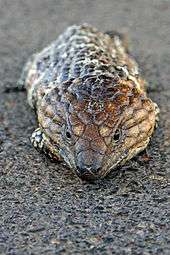
Tiliqua rugosa is an omnivore that eat snails, insects, carrion, vegetation and flowers. The species was once preyed upon by dingos, Australian pythons such as Morelia spilota, and local peoples; a threat is now more likely to come from large, introduced feral species, such as foxes and cats.[16]
They have also been known to eat human food, such as sausage and chicken, as well as fruits such as banana and passionfruit.
In captivity
The shingleback skink has become a popular pet among Australian enthusiasts. They are relatively docile and easy to feed and maintain. A permit may be required to keep them in some areas.
Reproduction
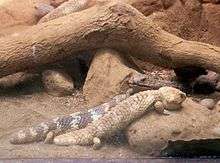
T. rugosa is a viviparous skink, giving birth to broods of one to four relatively large offspring.[6] Unlike most lizards, the species tends to be monogamous extending outside the breeding season of September through November; such pairs have been known to return to each other every year for up to 20 years.[6][17]
When they are born, the young immediately consume their afterbirth.[6] They stay with their parents for several months before moving on, but they remain in close proximity, forming a colony of closely related skinks.[6]
The male of a monogamous pair eats less while parenting, remaining alert and ready to give an alarm.[6]
Hearing
Their hearing can be measured at the round window as cochlear microphonics and summating potential (of the cochlea), and compound action potential and single-fibre responses (of the auditory nerve). These indicate a best hearing range near 1000 Hz. Earlier reports that their hearing sensitivity varied with the season[18][19] have been shown to be an artefact of the seasonally varying sensitivity to anesthetics.[20]
Single-unit recordings from the auditory nerve show both spontaneous and nonspontaneous responses. Tuning curves show peak sensitivity between 200 Hz and 4.5 kHz. The absolute sensitivity is quite high, with some thresholds at 6 db sound pressure level, very close to human best sensitivity.[21]
References
- Gray, J.E. (1825). A synopsis of the genera of reptiles and Amphibia, with a description of some new species. Annals of Philosophy 10:193—217. p. 201
- Tiliqua rugosa at the Reptarium.cz Reptile Database
- City of Wanneroo (2009). "Bushland Critters" (PDF). Retrieved 9 November 2010.
- "Shingleback Lizard". The Australian Museum. Retrieved 28 March 2020.
- "Noongar Word List | Kaartdijin Noongar". www.noongarculture.org.au. Retrieved 28 March 2020.
- Pianka, Eric R.; Vitt, Laurie J. (2003). Lizards: Windows to the Evolution of Diversity (Organisms and Environments, 5). 5 (1 ed.). California: University of California Press. ISBN 978-0-520-23401-7.
- Gray, J. E. (1845). Catalogue of the specimens of lizards in the collection of the British Museum. London: Trustees of die British Museum/Edward Newman.
- Mertens, R. (1958). "Neue Eidechsen aus Australien". Senckenbergiana Biologica (in German). 39: 51–56.
- Shea, G. M. (2000). "Die Shark-Bay-Tannenzapfenechse Tiliqua rugosa palarra subsp. nov.". In Hauschild, A.; Hitz, R.; Henle, K.; Shea, G. M.; Werning, H. (eds.). Blauzungenskinke. Beiträge zu Tiliqua und Cyclodomorphus (in German). Münster: Natur und Tier Verlag. pp. 108–112. ISBN 3-931587-33-9.
- Cogger, Harold G. (2000). Reptiles and Amphibians of Australia. Sanibel Island, FL: Ralph Curtis Books. ISBN 0-88359-048-4.
- Browne-Cooper, Robert; Brian Bush; Brad Maryan; David Robinson (2007). Reptiles and Frogs in the Bush: Southwestern Australia. University of Western Australia Press. p. 99. ISBN 978-1-920694-74-6.
- Sleepy lizards' monogamous lives tracked by researchers ABC News, 26 December 2015. Retrieved 16 April 2017.
- Wilson, S. & Swan, G. (2003). A complete guide to reptiles of Australia. New Holland Publishers, Sydney. ISBN 1 876334 72 X
- "Archived copy". Archived from the original on 22 November 2008. Retrieved 12 October 2009.CS1 maint: archived copy as title (link)
- Life, death and a sleepy lizard: One researcher's remarkable work on a monogamous blue-tongue ABC News, 16 April 2017. Retrieved 16 April 2017.
- C. M. Bull, and Y. Pamula (1998). "Enhanced vigilance in monogamous pairs of the lizard, Tiliqua rugosa" (PDF). Behavioral Ecology. Oxford University Press. 9 (5): 452–455. doi:10.1093/beheco/9.5.452. ISSN 1465-7279. Retrieved 12 April 2008.
- Bull, C. Michael; Cooper, Steven J. B.; Baghurst, Ben C. (1998). "Social monogamy and extra-pair fertilization in an Australian lizard, Tiliqua rugosa". J. Behavioral Ecology and Sociobiology. 44 (1): 63–72. doi:10.1007/s002650050515.
- Johnstone, J. R. & Johnstone, B. M. (1969). "Electrophysiology of the lizard cochlea". Experimental Neurology. 24 (1): 99–109. doi:10.1016/0014-4886(69)90008-9. PMID 4306107.
- Johnstone, J. R. & Johnstone, B. M. (1969). "Unit responses from the lizard auditory nerve". Experimental Neurology. 24 (4): 528–537. doi:10.1016/0014-4886(69)90156-3. PMID 5799201.
- Koeppl, C.; Manley, G.A. & Johnstone, B.M. (1990). "Peripheral auditory processing in the bobtail lizard V Seasonal effects of anaesthesia". Journal of Comparative Physiology. 167 (1): 139–144. doi:10.1007/bf00192413.
- Manley, G.A.; Koeppl, C. & Johnstone, B.M. (1990). "Peripheral auditory processing in the bobtail lizard I Frequency tuning of auditory nerve fibers". Journal of Comparative Physiology. 167 (1): 89–99. doi:10.1007/bf00192409.
Further reading
| Wikispecies has information related to Tiliqua rugosa |
| Wikimedia Commons has media related to Tiliqua rugosa. |
- Lysaght, Gary-Jon; Corvo, Shannon (19 February 2020). "Fleas and ticks may be creating new sub-species of shingleback lizards". ABC News. Australian Broadcasting Corporation. Retrieved 20 February 2020.